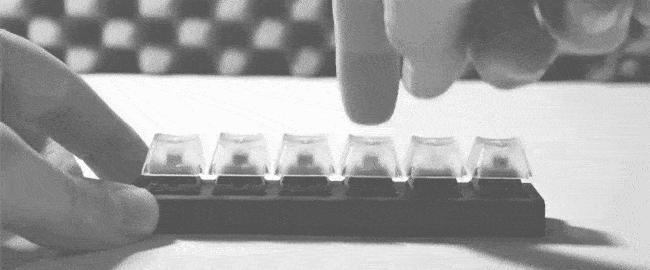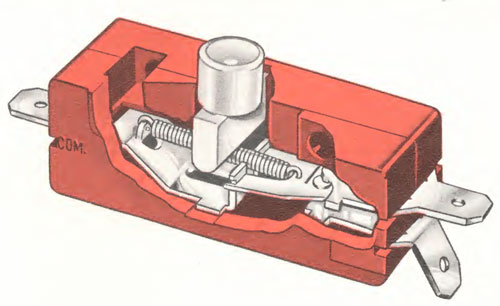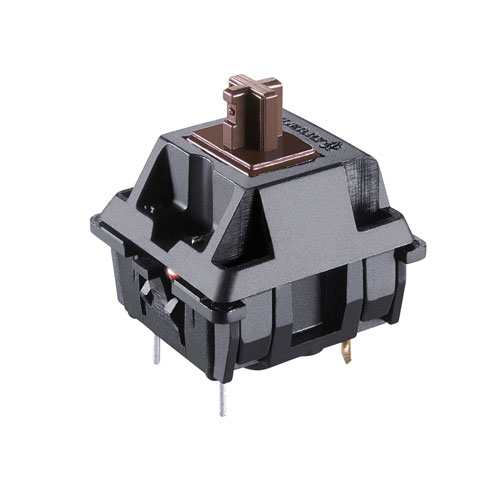Klats, klats: the story of Cherry, famous for the switches for keyboards
- Transfer
The famous manufacturer of mechanical switches for Cherry keyboards has existed since the 1950s - but only the last decade is associated with them.

Sometimes a company, occupying a certain niche of the market, determines its fate as an enterprise destined to exist for a very long time. One can hardly imagine a niche position than a keyboard switch. Most people don’t even think about this device, unless it’s about how the MacBook Pro can handle it.with the only bread crumb. But at the same time, keyboard switches - mechanical devices that convert keystrokes to data - this is exactly what ensured the long-term success of Cherry, a company whose name will not tell most people, unless they are fond of keyboards - in the latter case, it will seem to them that this company is omnipresent. You could hear the Cherry MX switches clanging, which so confidently became a cultural phenomenon that even Scrabble manufacturers recognized it . But what you might not know is the fact that until relatively recently, the manufacturer of the Cherry keyboard switches with surprisingly rich history did not concentrate on these switches at all. And that's what he did in their place.
In 1953, Cherry Electrical Products was founded in the basement of a restaurant located in the city of Highland Park, Illinois. The company's founder, Walter Cherry, had long been interested in electrical engineering, but he was dissuaded from a similar career in the 1930s by his parents, who considered that Thomas Edison had already made all the significant achievements in the field of electricity. It turned out that his parents were wrong.

Cherry E13-00E microswitch
Before Cherry became known for its keyboards, the entire business of the company was built around electronic switches. And although parents were skeptical about the career path chosen by Walter, it’s perfectly logical that he eventually became an entrepreneur. The fact is that this company was not the first large company named after one of the members of the Clan Cherry. JG Cherry Company, named after Walter's grandfather, was the main supplier of dairy products, founded in 1898 in Cedar Rapids, Iowa. His father, Walter Sr., served as president of the company when, after a series of mergers, in 1928 she became Cherry-Burrell Corporation .
Perhaps Cherry did not follow in the footsteps of the family business, but he created a new one — who had used his interest in electrical engineering well. The company quickly became known for its electronic switches, in particular - microswitches, which (despite the fact that they were not the first on the market) received the nominal name cherry switches.

The main page of the Cherry business handout brochure, which, as stated, was fully dedicated to switches.
With the help of computer legend and spam collector Ted Nelson , the Internet Archive has compiled an extensive collection of directories that advertised some of the 1960s Snap-Action switches from Cherry Electronics. In one avenueThe following advantage of the company for potential customers-manufacturers was advertised: “The whole company is completely dedicated to one product - switches. This specialization means thorough application analysis, efficient and reliable switch assembly, automated testing technology and fast service. ”
And although today the company is best known for its keyboards, these switches are not at all like the perfectly clicking mechanisms that Massdrop fans and active writers have been adoring for many years.
Where were they used? A vivid example of a place in which you could use Cherry switches, unaware of this, is arcade machines .
Anyone who spent the 90s playing a game of SNL machines would say that these big red buttons needed a quick reaction, a special feeling and a skillful approach. Microswitches were specifically designed for this purpose, and gave a special response with minimal delay.
But these switches could be found not only in the novelties of technology - they were used everywhere, from industry to home appliances, and the Cherry microswitches were the gold standard.
They had such an extensive fan base that when popular blogger Clint Besinger published a pleasantly satisfying video clip in which he presses the switch from 1959, more than 200,000 people watched it — not bad for a guy who is usually limited to a lighter description of old video games and hardware. .
Have you met up with the Cherry switch until today, or not, you probably used one of them, which helped ensure the growth of the company. By the 1980s, Cherry switches, sensors, and semiconductors (as well as some other devices) began to appear even in cars, the complexity of which gradually increased.
By 1981, the Chicago Tribune newspaper published an interview with Walter Cherry, who noted that his company supplies Ford and others, and their switches are used in air conditioners, electric locks and power windows. The company has spent millions of dollars creating auto parts, and considers this to be an excellent field for growth.
“The potential of electronics is huge,” said Cherry at the time. “Detroit is using more and more computers in its cars, and all their microprocessors need input. They buy sensors that provide information from people like us. ”
Soon, Cherry's automotive business flourished, and in the 1990s was one of the most important areas of work for the company. In 2005, the company, which had acquired many international branches by that time, produced 80% of the electric switches for European cars.
Unlike the history of the computer hardware company. Why is the name Cherry today so closely associated with keyboards, and not with auto parts? It is here that the history of the company is complicated.
In 1973, Cherry received a patent for its first keyboard switch, which became part of a series called the M6. This opened up a company that grew up in the field of industrial components, a path to the consumer market. Although, of course, their keyboards did not always go directly to consumers - and to this day the company manufactures highly specialized products for medicine and sales outlets. By 1990, the company had many branches in other countries, so it temporarily lost interest in the production of keyboards. As a result, she moved the production of keyboards to Germany, which allowed her to call her switches "German technology", despite her American origin.

Cherry MX Brown
switch As a switch, the Cherry MX was the defining product of a company that appeared several decades before it.
By the 1990s, Cherry was producing a huge range of products for automobiles in a factory in Illinois and beyond - more than 3,000 components of all shapes and sizes, mostly, of course, switches, but not only. As a result, with the growth of the company, it moved its headquarters to Wisconsin.
Walter Cherry, who gained a reputation as a strong manager and an astute investor in the global market in the early years of the company, returned to the research and development department in recent years, before leaving this world in 1996 . By that time, the firm was by and large a family-owned business, and his son Peter was the chairman of the board of directors, but in the end, she still took her present look, and concentrated on the keyboards, after the 2008 merger.
That year, Cherry Electronics was bought by German company ZF Friedrichshafen , which specializes in car parts similar to those used by Cherry for a long time.
As a result, the purchase forced ZF Friedrichshafen to redirect the Cherry brand to a business that was completely unrelated to spare parts - to the keyboards, the production of which Cherry did an excellent job, but eventually pushed it aside in favor of more attractive markets.

Patent for Cherry MX. It was discontinued relatively recently, and as a result, many competitors began producing clones of these keyboard switches.
It turned out that while computers were increasingly focused on customization, the keyboards had their own appeal. Cherry’s decades of work on keyboards came in handy in the era of do-it-yourself lovers, people willing to spend extra money on keyboards that look and sound just the way they wanted. The keyboards from Apple and Microsoft were getting thinner and used less pleasant membrane substrates that were sensitive to pressing, the Cherry keys remained pleasant and springy as they continued to use their own special mechanical switches.
It was the MX switch, which the company first manufactured in the 1980s, that was decisive for the name Cherry. His patentedin 1984, and it represented the culmination of most of the company's work on the switches used for data entry. He is famous for his options in different colors, each of which represents the unique properties of the switch, the most famous of which will be soft, Cherry MX Red , MX Blue with a loud click, and still pleasant to press, but more quiet MX Brown . These keys are liked by lovers of customization and users of conventional keyboards.

Several open Cherry MX Red switches that prefer to use for games
Hobby lovers who dreamed of building their own keyboard showed unexpected interest in these keys - just like game lovers who have been shaping the development of the PC industry for decadesgraphics and high level audio. And also these keys were liked by ordinary people, who just needed a useful keyboard that had no less weight than the words they typed. Cherry switches, the wholesale price of which is not much higher than the cost of a real cherry [Eng. cherry - cherry / approx. perev.], allowed to make the keyboard, as pleasant to the touch, and undemanding to a particular appearance.
Whether the role of Cherry in this phenomenon was a happy case related to the merger, which forced the brand to concentrate on a narrow direction, or a natural phenomenon caused by influential people and word of mouth - as a result, in 2018, keyboard switches are in demand more than ever - especially Cherry switches.
And this is naturally reflected in Cherry's recent business history. By the time the private investment company GENUI bought the company in 2016, auto parts had never been mentioned in a press release announcing the purchase. It was only about keyboards, which means that the company is no longer suitable for ZF Friedrichshafen.
The old production of switches and sensors for cars, vending machines and power tools, still lives, the company ZF Friedrichshafen supports this line, although it renamed it ZF in 2016.
Cherry has burst into the keyboard market so abruptly that ZF cannot be blamed for the division of production lines. In 2015, the Cherry MX data entry and switch business provided companies with more than € 80 million in profits.
That's a lot - considering that some users of technology consider mechanical keyboards to be a niche device.
The purchase of ZF Friedrichshafen in 2008 by Cherry completely turned the switch manufacturing from America into a keyboard company that looks more like a German one.
Today, the company is already so German that the technological YouTube icon Linus Sebastian came to this factory a few years ago, for some reason dressed in Lederhose Bavarian leather pants . Simply put, the company looks completely different from when it was completely independent.
Shortly before his death in 1996, Walter Cherry probably believed that his legacy was in an electronic company that produced spare parts for industry; a company that created a lot of small cars that helped work large machines. But a little more than twenty years later, the average consumer, who knows the Cherry brand, first of all considers the company to be a manufacturer that copes well with the production of a small machine of the same type - a keyboard. The company is still laid the DNA of its creator, but she completely changed.
Somehow, the Cherry brand became better known after all these mergers and acquisitions. Usually the opposite happens - that is why this case is very interesting to study against the background of modern startups, which seem to grow and thrive in very similar ways. Cherry didn't just appear on Product Hunt or Kickstarter; she has worked hard for more than 60 years before being noticed by many technology enthusiasts.
Cherry's story tells how a B2B company has somehow become a B2C company. But she also talks about something else. It demonstrates that while computers are getting smaller and more concentrated on touch input, there will always be those who prefer something more tangible.
Of course, the company has skeptics - those who believe that today the keyboard switches are not the same, and even showing statistics to confirm their words; but she also has a lot of fans who would rather use small cars that react to each press than go down to devices that look more like lumps of porridge.
Simply put, in a world with many moving parts, a company like Cherry is thriving.
[ I was pleased to type this translation on my mechanical keyboard with Cherry MX Brown switches / approx. trans. ]
